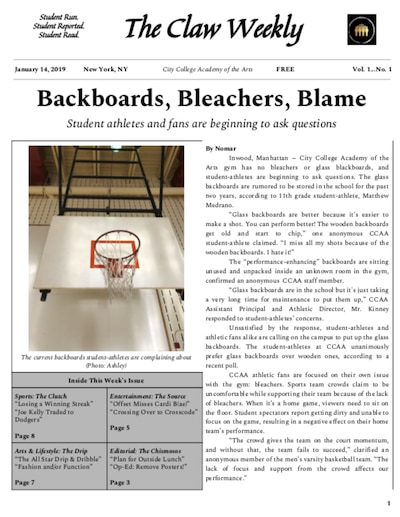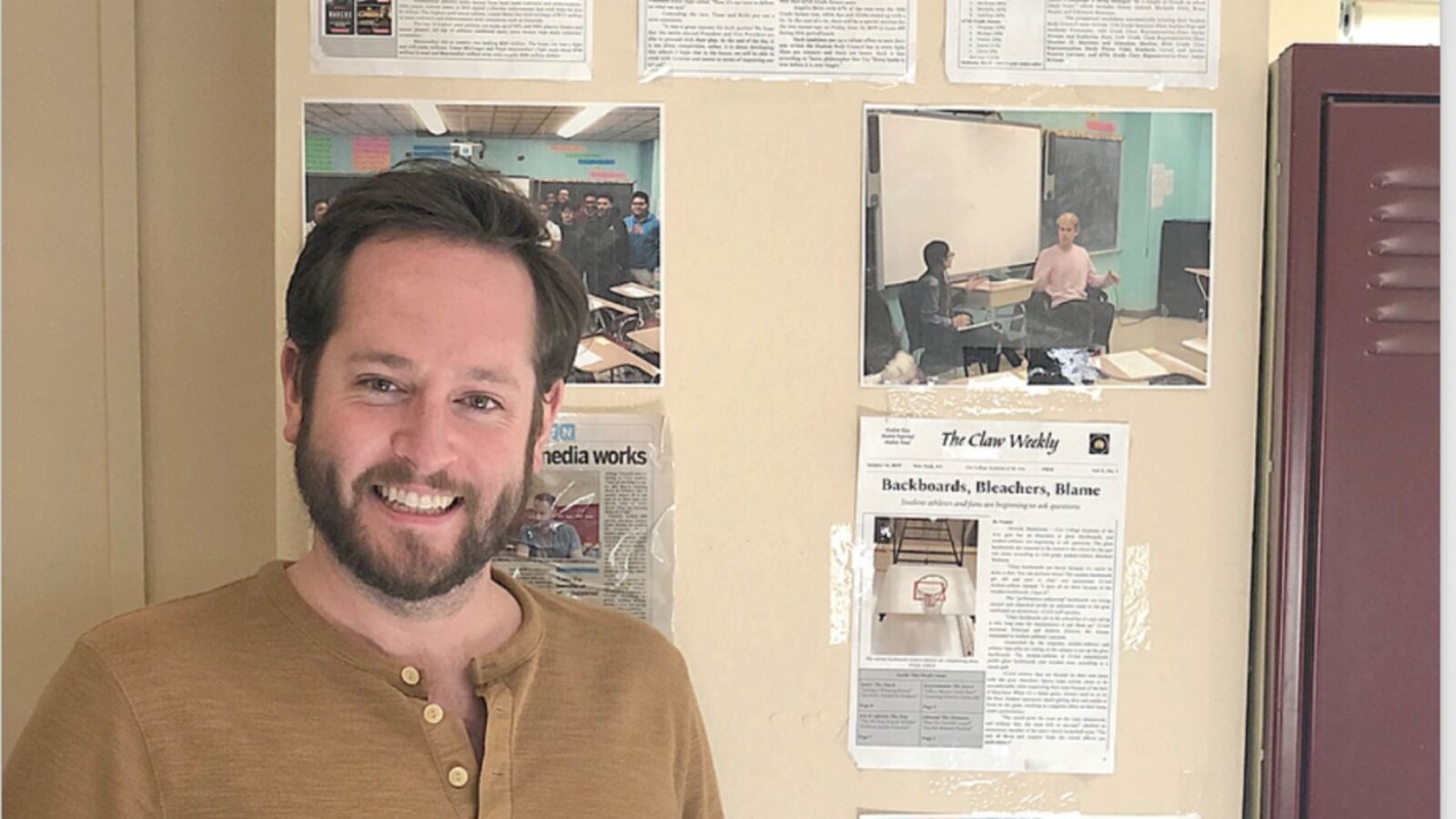Before becoming a New York City public school teacher, Dennis Mihalsky worked in public relations.
So it wasn’t a big leap when he launched a journalism unit in his high school English class at the City College Academy of the Arts, a school serving sixth- to 12th-grade students in Manhattan’s Inwood neighborhood. But Mihalsky didn’t fully anticipate his students’ response.
“They would be asking and pitching me stories even when they weren’t in class,” he said. “From the highest-level student to the lowest-level, they were all able to engage in what we were doing.”
The first issue of the student publication they created included a story about how the school kept new basketball backboards in storage, failing to replace the old wooden ones. Students almost immediately saw results: Weeks after the story was published, the backboards were replaced. With positive responses from students, the principal’s blessing, and a new color printer, Mihalsky’s class would officially launch a school newspaper called The Claw.
Building on that success, Mihalsky has started an organization called Students Disrupting to expand the number of schools across the city that have student news operations. It’s still in its early phases, but Mihalsky is hoping to offer advice to other schools that are interested in starting newspapers but might not know where to start or how to keep it going (two schools have expressed interest so far, he said). We caught up with him recently to learn more about how he got interested in journalism and his teaching practice more broadly.
The interview has been edited for length and clarity.
Why did you want to launch a student newspaper at your school?
I noticed students weren’t aware of the many issues facing our country and even our community that directly affect them on a daily basis. Many would tell me they didn’t read the news because it didn’t appeal to them or that they got their news directly from social media. As an avid consumer of the news and a staunch believer in civic engagement and awareness, I realized, along with my co-teacher, Ms. Dawn Hunter, that we needed to develop a media literacy unit.

How did you prepare to teach students to report and write stories?
I spent a lot of time researching student journalism and the various ways in which a school can start a student-run newspaper. I have a background in public relations, so I’ve been immersed in the media industry for quite some time, but previous to the school paper it was in more of a consulting and messaging capacity.
So I used my experience and knowledge to introduce students to the media landscape, how news begins to get noticed and take shape, and how it is covered in the profession of journalism. As a fervent consumer of news, I introduced my personal observations about what makes for impactful news coverage, as well as what makes for a diligent and responsible newspaper which prioritizes credibility and a rigorous reliance on facts over sensationalism.
Have your students reported any stories that surprised you?
Yes, multiple times. Once we started the newspaper, students started coming to me with story ideas that I never would have conceived of on my own. For instance, one student informed me about new glass backboards for the school’s basketball courts that had been in storage for over two years but had never been put up to replace the old wooden backboards.
The student did a full investigative story by asking anyone with knowledge of the situation about the facts relating to the delay. The story was so well researched and written that it made our newspaper’s inaugural issue cover story. Other examples include issues that are immediate and collectively personal to the students that may be overlooked, like school lunches, uniform policies, and teacher practices.
Was your school’s leadership supportive of the project, despite potentially getting greater scrutiny?
I’m extremely lucky to have a principal and administration that has supported our newspaper and newspaper class from the start. It was actually my principal who came to me after the first issue to inform me that the class would transform into a full-fledged, working newspaper operation, from writing and editing to publication. Even with some articles being critical of policies and issues happening within the school, my principal celebrated the students’ criticism and would typically address these issues and their concerns in class, employing a strategic device somewhat akin to holding a press conference.
How have your students responded?
The students who typically wouldn’t respond well with new units or just wouldn’t be engaged were continuously addressing me in and out of class with ideas for their next article. Many students who were otherwise once distracted or disruptive or disengaged in other classes began to look forward to school.
Paper or assignment deadlines they may have often missed in other classes became article deadlines, and they began to meet them time and time again. They were no longer working hard in school just for grades. Instead, they were working hard at their assignments in an effort to make them the best they could be and for the positive effects their stories had on individuals other than themselves.
Publication day is always exciting and students from all grades often run quickly to get a copy of the newspaper, and the rest of the day I see students sitting together reading and pointing at the stories, and even discussing them with friends.
It may seem counterintuitive, but even in a world so dominated by — especially for young people — electronic modes of information sharing and dissemination, the students were especially thrilled to touch, hold and read the printed publication. It gives us all hope for paper!
What was your biggest misconception that you initially brought to teaching?
Based on what I was taught in my graduate studies, I was always told not to go into a school thinking you can change the world. I was told instead to keep my head down, do what I was told, and focus on getting tenure. I was told that I wouldn’t be able to propagate, foster or precipitate significant change, but that if I can make a difference in one student’s life, I would be successful.
Once I was in my school, I saw many opportunities to change what was happening inside the school for the better, and it quickly changed my way of thinking.
Going against all the best-intentioned advice, I started my school’s first debate team. I became involved in my union and later was elected Chapter Leader (while being untenured). I started the school’s newspaper and student council.
I now make it my business to regularly call on all new teachers to be the facilitators of change in my school, and reject the notion that a teacher should just “do what they have to do.” I believe it is an antiquated way of thinking, which perpetuates the failures we so often have such a hard time overcoming in our education system.


